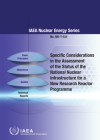A research reactor project is a major undertaking requiring strict attention to nuclear safety, international safeguards, nuclear security and the control and accounting of nuclear materials. The IAEA helps its Member States develop the necessary infrastructure to build and operate such reactors.
Research reactor infrastructure
Constructing a research reactor involves careful planning and preparation, as well as long-term investment of human and financial resources. The need for funding and government oversight extends well beyond the usual timescales for a capital project of similar size. Many research reactor projects involve a wide range of interests and sometimes their missions evolve over time. Research reactors also require additional funding to that provided for research alone, such as for operation and maintenance, as well as waste management and decommissioning.
To embark on a research reactor programme, several initial conditions need to be met:
- based on national or regional needs, the construction of the facility needs to be justified;
- available and feasible alternative technologies must be explored; and
- sufficient financial, technical and human resources must be made available.
Once these steps have been taken, the supporting infrastructure must be developed and set up. This includes the physical facilities; associated equipment; and the framework for the handling of fresh and spent fuel, the management of radioactive waste, and the transportation of nuclear material and supplies. Aside from these practical elements, the infrastructure for a research reactor also requires the setting up of the necessary legal, safety, security and safeguards frameworks.
The IAEA has developed the Milestones Approach, an assistance initiative for Member States interested in building the infrastructure for their own nuclear power programme. Under this approach, the Agency provides comprehensive guidance on the timely preparation of new research reactor projects through specific development phases. This includes those national infrastructure issues that need to be addressed for such projects, such as human resource development and the implementation of new technologies, structures and components to satisfy the evolving demand for research reactor goods and services. The IAEA also organizes specific training events and peer reviews, among them the Integrated Nuclear Infrastructure Review for Research Reactors (INIR-RR) mission.
Using research reactors for education and training
Research reactors are excellent tools for education and training because they give access to students, nuclear sector employees and the wider public to the practical applications of nuclear science and technology. Used to their full potential, these facilities not only help educate the public on nuclear science, but can also generate more funding and stronger support for nuclear technology at large. Their education and training programmes can encompass all facets of civil society, from high school and university students to the general public, to power reactor operators and safety authority staff.
The IAEA works with Member States to develop a variety of nuclear education and training programmes. One such project is the Internet Reactor Laboratory (IRL), a cost-effective way to add an experimental component, based on the use of a research reactor, to university curricula where otherwise such an opportunity might not exist.
The IRL creates a virtual reactor in a remote location by linking a host reactor with university classrooms in other countries. Using data acquisition hardware and software installed in the host research reactor, real-time signals are sent over the internet to the participating classroom, where students are able to see the live display of the reactor’s control panel. Using a video conference link, students can conduct experiments by asking the reactor operators in the control room to change reactor settings and see real-time output. This type of virtual training helps Member States without an existing research reactor develop a nuclear infrastructure for newcomer nuclear power programmes.





